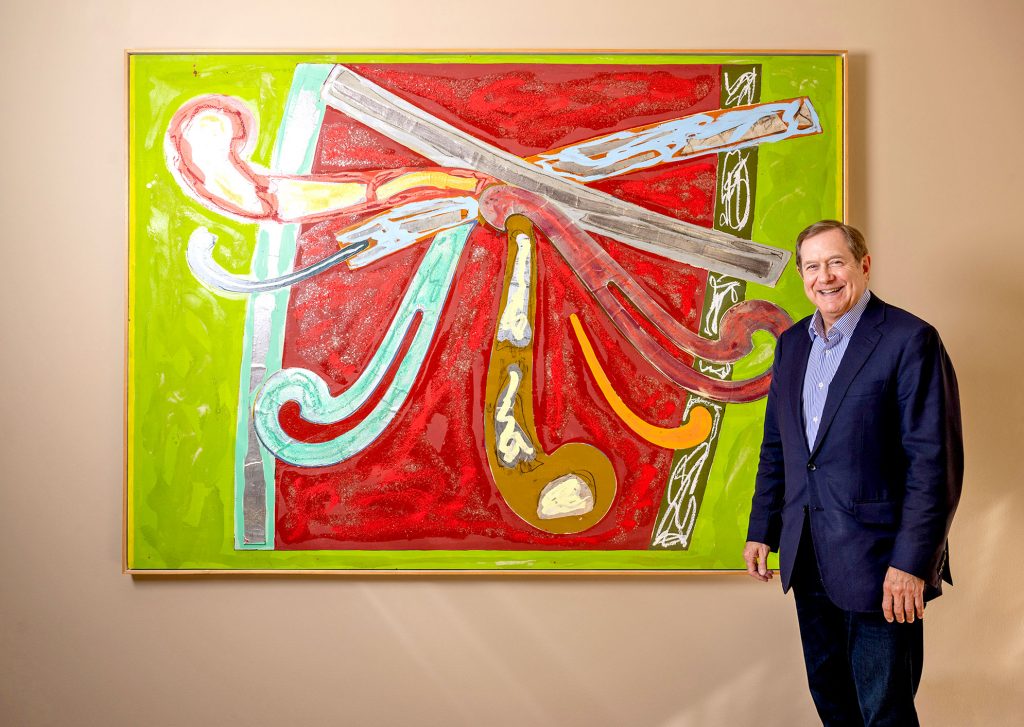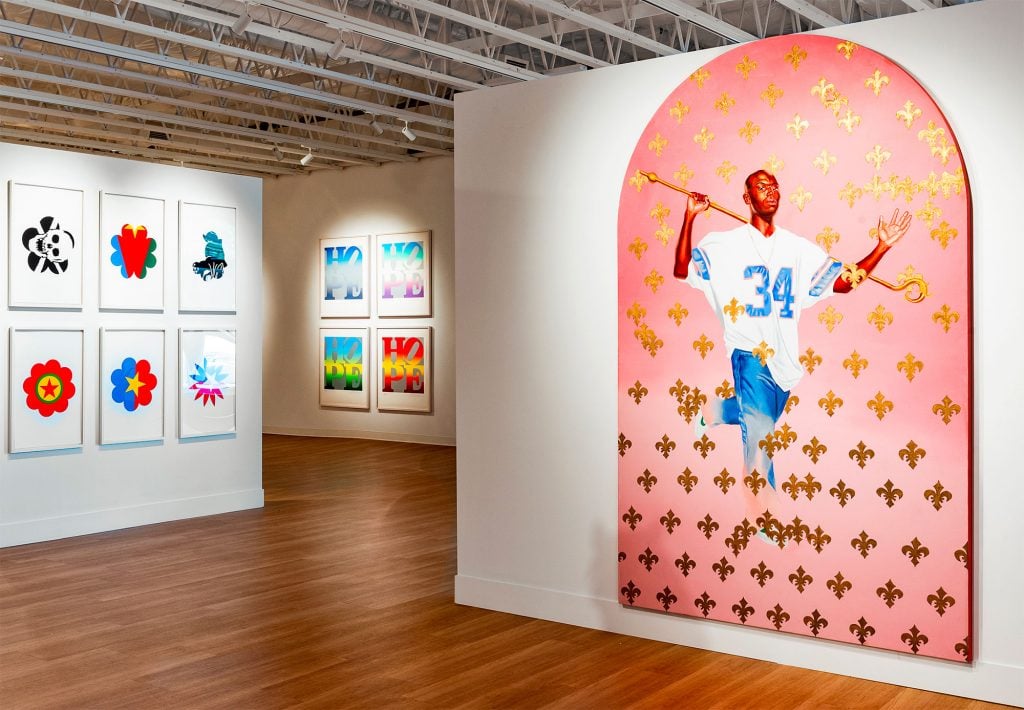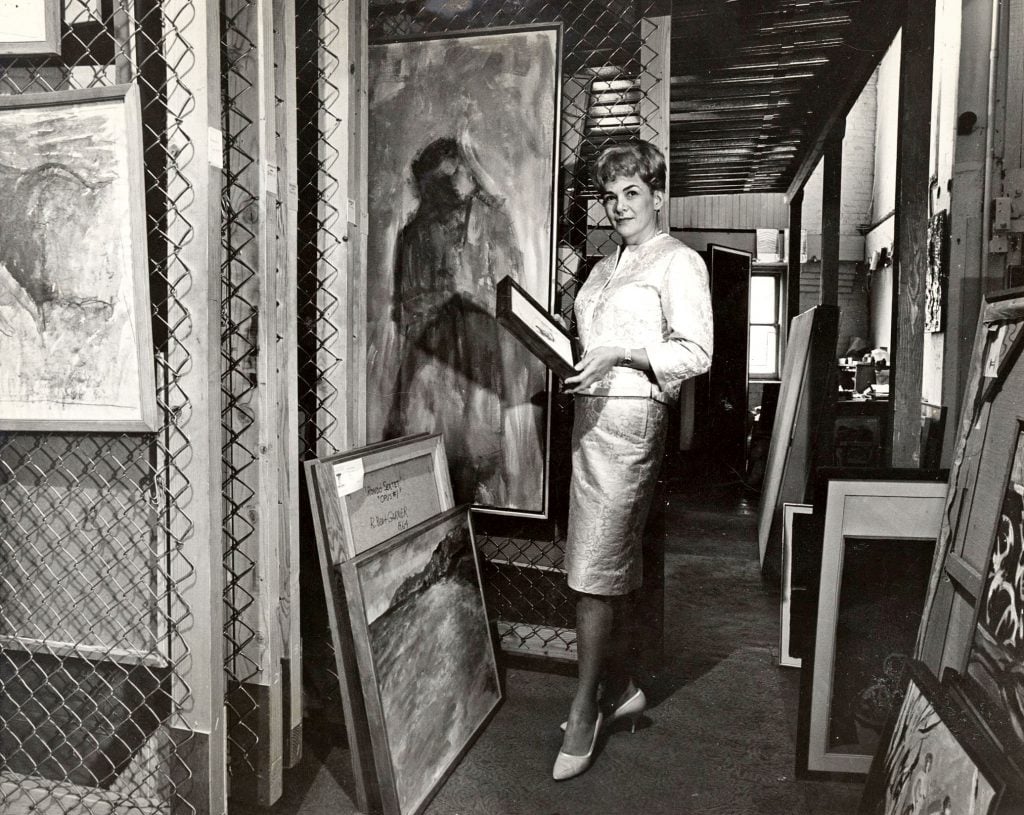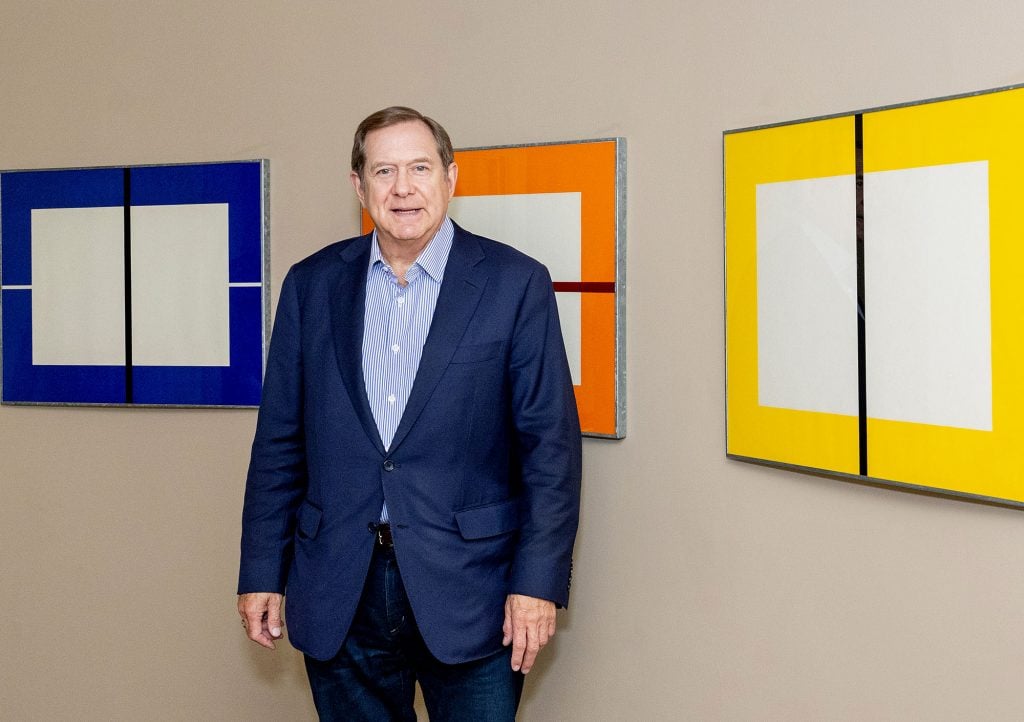What I Buy and Why
Philanthropist Jordan Schnitzer on the Joy of Sharing His Collection and the Art He Wakes Up to Every Day
As remarkable as his 22,000-strong collection is his mission to exhibit it as widely as possible.

By his own estimate, Jordan Schnitzer has amassed 22,000 paintings, sculptures, prints, and other objects by roughly 1,500 artists. It’s a prodigious collection, to be sure, making the Oregonian philanthropist and real-estate magnate the largest private owner of several important artists’ works—among them Kara Walker, Hank Willis Thomas, and Jeffrey Gibson (who’ll represent the United States at the 2024 Venice Biennale). Most recently, he acquired the largest collection of Judy Chicago’s oeuvre and helped sponsor the artist’s current show, “Herstory,” at the New Museum in New York.
Yet, while the Portland-based patron is passionate about collecting—which he does on a “weekly basis”—he’s just as adamant that others have the opportunity to experience the works, too. “If there is any legacy that I am able to have, it will be sharing art with people,” he said. In addition to exhibiting shows at Schnitzer’s own gallery, his Family Foundation organizes exhibitions in museums around the country, loaning items culled from its state-of-the-art warehouse in Portland. To date, the foundation has paved the way for over 160 such exhibitions at 120 institutions and counting.

Installation view of “We Are The Revolution,” on view at the Schnitzer Collection in Portland, Oregon, through December 1, 2023.
Of those roughly 22,000 pieces in his collection, just over half are prints—his abiding fascination. Over decades, Schnitzer has built the largest private collection of prints and multiples in the U.S.—including 1,400 by Andy Warhol, nearly half of those unique—and has staunchly supported institutions dedicated to the medium, such as the Print Center New York, whose new gallery is named after him. Further, he’s a regular attendee at the IFPDA Print Fair in New York and will participate in a panel discussion on Ellsworth Kelly‘s printmaking practice at this year’s edition (October 26–29).
Through it all, Schnitzer insists that his sprawling collection be made available for others to enjoy. “While I technically own all this art,” he said, “I have no sense of ownership, only a huge sense of stewardship.” He reminisced about sending Chuck Close works to the Maryhill Museum of Art, east of Portland, and busing in 300 young students to view the show, giving them art lessons to take back home. “I was so touched when an eight-year-old boy made a little sort of Chuck Close image on an ink pad,” he said. “I wrote Chuck Close a letter about that and he was so enthusiastic in his response to me about how appreciative he was that I could get his work to audiences that might otherwise never see his art.”
We caught up with Schnitzer for a glimpse into the mind of the people’s collector.
What was your first purchase?
After my mother, Arlene Schnitzer, opened the Fountain Gallery of Art in 1963 in Portland, Oregon, I started getting art for my birthdays, Hanukkah, and other events. But my first purchase was June 23, 1965. I bought a small painting, a study by Portland artist Louis Bunce called Sanctuary. It was $75 but with the family discount I had to pay $60. So, I paid $5 a month out of my allowance. But if I ever missed a payment, I knew my mother could foreclose because my bedroom was next to my parent’s bedroom! I’ve had that work with me ever since.

Arlene Schnitzer. Courtesy of Jordan Schnitzer. Courtesy of Jordan Schnitzer Family Foundation.
What was your most recent purchase?
In addition to buying lots of prints and multiples from the major print publishing companies around the country and many galleries, I have also bought a significant amount of my collection from the auction houses. I’m fortunate to work with the International Head at Sotheby’s, Christie’s, Phillips, Bonhams, and Heritage.
In fact, there was a Sotheby’s auction last week of the late, great collector Leslie Garfield, and I bought 25 things from his collection, including an edition set of Roy Lichtenstein prints I did not have, an Alison Saar ceramic piece, several Mark Bradford amazing works, and others. I generally buy art on a weekly basis and as disciplined as I try to be, it certainly is an obsession!

Jordan Schnitzer with a Jasper Johns lithograph, Cicada (ULAE 219) (1981). Courtesy of Jordan Schnitzer Family Foundation.
Tell us about a favorite work in your collection.
When I’m asked what my favorite work is in the collection, I think it’s like a parent being asked, “Who’s your favorite child?” And the answer generally is, it depends upon the day! There are so many works in our collection that just make my knees weak, period.
I never cease to be shaken up when I see Kara Walker’s art, which is currently on display at the USC Fisher Museum of Art. The power and guts of this artist to do work that makes us feel properly uncomfortable is an achievement. Every single work of Warhol, Roy Lichtenstein, Ellsworth Kelly, and Frank Stella takes my breath away.

Jordan Schnitzer’s dining room with a Damien Hirst etching, left, and Robert Rauschenberg’s Tibetan Locks (Avenue) (1987), right. Courtesy of Jordan Schnitzer Family Foundation.
Which works or artists are you hoping to add to your collection this year?
Current artists such as Hank Willis Thomas, Wangechi Mutu, Mickalene Thomas, Kehinde Wiley, Wendy Red Star, and Marie Watt create powerful works of art that stop me in my tracks and make me appreciate how lucky I am that I love art. Though our collection already includes these artists, I always keep an eye out for their latest works and exhibitions. I’m very pleased many of Marie Watt’s prints in our collection will be on view at Print Center New York this coming January.
What is the most valuable work of art that you own?
While I keep track of current values for insurance purposes, the most valuable pieces of art that I own are two small etchings that were done by my two daughters, Arielle and Audria Schnitzer. Years ago, when they were seven and nine, we were in San Francisco and we went to visit Crown Point Press. I peeked my head in to see if Kathan Brown, the founder, was there. She was.
I asked if she would give a tour of the presses to us in the back of the gallery. She did, but then amazingly put on a smock, sat my two daughters down, brought out two copper plates and special etching pens, had them make drawings, and then she herself put them through the original press that she’d bought in the early 1960s that started Crown Point Press. Kathan did whisper to me that she hadn’t done any printing herself for 25 years, but they’re beautiful black and white etchings that I always treasure. They are the most valuable works of art that I own.

Schnitzer with untitled woodcuts by Donald Judd (1993). Courtesy of Jordan Schnitzer Family Foundation.
Where do you buy art most frequently?
The IFPDA Print Fair regularly features exceptional prints and we’ve collected from the fair over many years. I also work with a dozen galleries that feature artists that I collect such as Carolina Nitsch Contemporary Art, Matthew Marks Gallery, Alan Cristea Gallery, Hauser & Wirth, Sikkema Jenkins, Lococo Fine Art, LA Louver, and James Cohan Gallery. And of course I have long-standing relationships with all the auction houses like Christie’s, Sotheby’s, Bonhams, and Phillips.
Is there a work you regret purchasing?
There are so many I regret not purchasing. But, I think that’s a nice thing. I can’t imagine being able to get everything one wants. That’s what’s wonderful about building this collection. It will never be finished. And it’s nice looking forward to getting things and hopefully sometimes getting them, and other times realizing you just weren’t at the right place at the right time to get something.
An example is Cy Twombly‘s Roman Notes. Susan Sheehan, a dealer in New York, had a perfect copy for $36,000 about 20 years ago. I didn’t have the money to buy it then. It then went to $60,000, then $80,000, then $150,000, then $250,000, $300,000, $400,000, and $500,000 now. Every time I see the nine images, my heart starts beating and I have the same emotional reaction to it I did when I first saw them. But that’s a lot more money to spend. Will I ever get the set? I hope so. But it’s an example of something I’ve always wanted but was not quite there yet.
What work do you have hanging above your sofa? What about in your bathroom?
I have three Jim Dines—wonderful pieces with big hearts. We have a work, a round wood spiral piece by Ryan McGinness, a small Sam Francis, a wonderful Frank Stella, Hockney’s Hotel Acatlan: Two Week Later, William Wegman and his fanciful dogs, Richard Serra, some work by local artists Jay Backstrand and Louis Bunce, a fabulous piece by Judy Chicago, several Lichtensteins, and a Chuck Close, to name a number of the artists that I wake up with every day.
Opposite the bathroom is the work Sanctuary by Louis Bunce that I bought when I was 14 years old. I say hello to the Louis Bunce every day.

Leonardo Drew, Number 215B (2019). Courtesy of Jordan Schnitzer Family Foundation.
What is the most impractical work of art you own?
There is no question, Leonardo Drew, the brilliant Brooklyn-based artist who created Number 215B. In his studio, I saw a work that was about 15 feet wide with probably a thousand pieces to it. I said to him, “I want that.” Little did I know it wasn’t finished. By the time it was finished, it was 25 feet wide with probably 2,000 pieces, which takes 40 crates just to store it and a whole 40-foot truck to ship it.
I got a tongue lashing from Catherine Malone, my collection manager, about how much storage space that piece took, but I’m honored to have it in the collection and every time it’s up, there isn’t a single person whose jaw doesn’t drop seeing the magnificent work that it is.
What work do you wish you had bought when you had the chance?
Which of us can’t look back and wish we’d had more money at earlier times in our life to have done many things with it? When I’m asked whether I own a Warhol painting, I’ll say, well no, the time for that was years ago when huge collectors were able to buy that work that was expensive then, but not the astronomical prices the work is now. With Warhol, we have 1,400 works including 650 unique drawings that make our collection a very special study center for his work. If I’d been collecting as much 40 years ago as I am now, maybe I’d have some Warhol paintings but that time has passed.
Right now, I’m buying paintings and sculpture by Kehinde Wiley and Hank Willis Thomas and Alison Saar and Wangechi Mutu and many other artists that are of our time now.
If you could steal one work of art without getting caught, what would it be?
If I were at MoMA in New York, had an hour, and I could take anything I want, it probably would be one or two of my favorite Picasso pieces that I can’t stop looking at. It would be a tough choice between one of those amazing Picasso pieces and a Mark Rothko.
I’ve often said that waking up without art around me would be like waking up without the sun. When you’re lucky enough to have art around you, whether it’s a $5 work of art from the Saturday market or whether your budget allows you to add a few zeros to that, the most important thing is having things around you that make you smile, make you frown, or continually challenge you to interpret what the artist’s message is. I feel so blessed to have the work in my collection. If I could just have one piece of art, let alone the thousands that I have, I’d feel like I was the luckiest guy in the world. It’s not how much; it’s having experience of having objects of beauty as part of your daily life.





